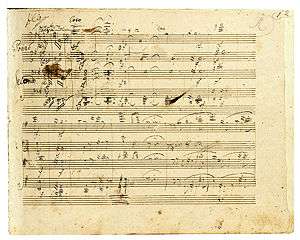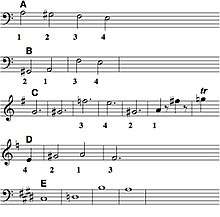Late string quartets (Beethoven)
Ludwig van Beethoven's late string quartets are the following works:
- Opus 127: String Quartet No. 12 in E♭ major (1825)
- Opus 130: String Quartet No. 13 in B♭ major (1825)
- Opus 131: String Quartet No. 14 in C♯ minor (1826)
- Opus 132: String Quartet No. 15 in A minor (1825)
- Opus 133: Große Fuge in B♭ major (1825; originally the finale to Op. 130; it also exists in a piano four-hands transcription, Op. 134)
- Opus 135: String Quartet No. 16 in F major (1826)

These six works are Beethoven's last major completed compositions. Although dismissed by musicians and audiences of Beethoven's day, they are now widely considered to be among the greatest musical compositions of all time,[1][2][3] and they have inspired many later composers.
Overview
Prince Nikolai Galitzine commissioned the first three quartets (numbers 12, 13 and 15) and in a letter dated 9 November 1822, offered to pay Beethoven "what you think proper" for the three works. Beethoven replied on 25 January 1823 with his price of 50 ducats for each opus.[4] Beethoven composed the quartets in the sequence 12, 15, 13, 14, 16, simultaneously writing quartets 15 and 13.[5]
Beethoven wrote these last quartets in failing health. In April 1825, Beethoven was bedridden and remained ill for about a month. The illness—or more precisely, his recovery from it—is remembered for having given rise to the deeply felt slow movement of the Fifteenth Quartet, which Beethoven called "Holy song of thanks ('Heiliger Dankgesang') to the divinity, from one made well". He went on to complete the quartets now numbered Thirteenth, Fourteenth, and Sixteenth. The last work Beethoven completed was the substitute final movement of the thirteenth quartet, which replaced the extremely difficult Große Fuge.[6]
The "ABC" quartets
Opus 132, 130 and 131 are sometimes called the "ABC" quartets because of their successive tonalities: A minor, B♭ major, and C♯ minor. They are thematically linked together over the four notes of the second tetrachord of the harmonic minor scale. This is explained by A. David Hogarth in his notes written for the recording of all six quartets by the Quartetto Italiano:[7]

What obviously intrigued Beethoven was the wide interval of a tone and a half between notes 2 and 3 [of example A]. In different permutations, the four notes play an important role in all three quartets and each work has a distinctive motto which also appears in companion works. The opening motto of op. 132, which ultimately reappears in op. 131's finale, consists of the first four notes of the opening bars (see example B).
The subject of the "Grosse Fuge” finale of the B flat major, op. 130 follows the same pattern with the rising sixth between notes 1 and 3 increased from minor to major (see example C).
Op. 131, the masterwork of the three, opens with a fugue and the subject's opening phrase (transposed) is as example D. (As such this motto is already predicted in the trio of op. 132's second movement.) The key notes from which these mottoes are built finally appear thematically in their original scale form in the finale of op. 131.
Beethoven's sketchbooks prove clearly that these permutations were not coincidental. Even if they were there would be other coincidences to explain - the ABC sequence of keys, for instance, and the fact that the quartets have successively five, six, and seven movements.)
It could be argued that op. 131 is a six-movement work for the third "movement" is only 10 bars long and has the same A major key signature as its successor. Some critics notably Vincent d'Indy, regard it simply as an introduction. But the tonality of the 10 bars is clearly B minor and if we note the tonal centres of the first four movements we get the familiar pattern of op. 132 and the "Grosse Fugue" (see example E). The keys of the remaining movements complete a cyclic progression back to C sharp minor.
Beethoven's "obsession at that time with the upper four notes of the harmonic minor scale" (A. David Hogarth) is actually older and can be found elsewhere in his works. For an early example, see e.g. the first movement of the trio for strings opus 9 nr 3, in C minor.
Appraisal
These last quartets went far beyond the comprehension of musicians and audiences of Beethoven's time. One musician commented that "we know there is something there, but we do not know what it is." Composer Louis Spohr called them "indecipherable, uncorrected horrors".
Opinion has changed considerably from the time of their first bewildered reception: these six quartets (counting the Große Fuge) comprise Beethoven's last major, completed compositions and are widely considered to be among the greatest musical compositions of all time.[8] The Frankfurt School philosopher Theodor Adorno, in particular, thought highly of them,[9] and Igor Stravinsky described the Große Fuge as "an absolutely contemporary piece of music that will be contemporary forever".[10] Their forms and ideas inspired and continue to inspire musicians and composers, such as Richard Wagner and Béla Bartók. Wagner, when reflecting on Op. 131's first movement, said that it "reveals the most melancholy sentiment expressed in music".[11] The last musical wish of Schubert was to hear the Op. 131 quartet, which he did on 14 November 1828, five days before his death.[12] Upon listening to a performance of the Op. 131 quartet, Schubert remarked, "After this, what is left for us to write?"[13] Of the late quartets, Beethoven's favorite was the Fourteenth Quartet, op. 131 in C♯ minor, which he rated as his most perfect single work.[14]
Other versions
Transcriptions of some of the late quartets for string orchestra have been made by Arturo Toscanini and Felix Weingartner, among others.
Recordings
Ensembles that have recorded all the late string quartets by Beethoven include:
- Alban Berg Quartet, EMI (studio early 80s)
- Alban Berg Quartet, EMI (rec. live 1989)
- Alexander String Quartet, Arte Nova
- Alexander String Quartet, Foghorn Classics
- Amadeus Quartet, DG
- Artemis Quartet, Virgin Classics
- Barylli Quartet
- Beethoven Quartet, Melodiya (rec. 1951-1972)
- Belcea Quartet
- Borodin Quartet, Chandos
- Brentano String Quartet, Aeon (rec. 2012)
- Budapest String Quartet, Bridge (rec. 1941-60)
- Budapest String Quartet, Sony (rec. 1958-61)
- Busch Quartet, various labels (rec. 1933-41; no Große Fuge)
- Cleveland Quartet, RCA (1970s)
- Cleveland Quartet, Telarc (1990s)
- Colorado Quartet, Parnassus (rec. 2004-06)
- Emerson String Quartet, DG
- Endellion String Quartet, Warner Classics (2005–06)
- Fine Arts Quartet, Everest/Concert-Disc (rec. 1960-65)
- Gewandhaus-Quartett, New Classical Adventure (rec. live 1985-98)
- Guarneri Quartet, RCA, Philips
- Hagen Quartett, DG
- Hollywood String Quartet, Testament
- Hungarian Quartet, (1953 mono) EMI
- Hungarian Quartet, (1960s stereo) EMI
- Juilliard String Quartet, CBS studio late 60s
- Juilliard String Quartet, CBS (rec. live 1982)
- Kodály Quartet, Naxos
- LaSalle Quartet, DG (reissued on Brilliant Classics)
- Leipziger Streichquartett, MDG
- Lindsays, ASV
- Lydian String Quartet, Centaur
- Medici Quartet, Nimbus
- Melos Quartett, DG
- Orford String Quartet, Delos
- Orion String Quartet, Koch Classics (2008)
- Penderecki String Quartet, Marquis (2013)
- Petersen Quartett, Capriccio
- Prazak Quartet, Praga
- Quatuor Mosaïques, Naïve
- Quartetto Italiano, Decca
- Smetana Quartet, Supraphon
- Suske Quartett, Berlin Classics
- Takács Quartet, Decca (2005)
- Talich Quartet, Calliope
- Taneyev Quartet, Boheme
- Tokyo String Quartet, RCA (1993)
- Tokyo String Quartet, Harmonia Mundi (2010)
- Vanbrugh Quartet, Intim Musik (1996)
- Vermeer Quartet, Teldec, (rec. 1984-89)
- Vegh Quartet, (1952 Les Discophiles Français) Music & Arts
- Vegh Quartet, (1972 Telefunken) Naïve-Astrée
- Wihan Quartet, Nimbus
- Yale Quartet, Vanguard
See also
References
- "Beethoven's String Quartets: John Suchet's guide to the music". Classic FM (UK). Retrieved September 29, 2017.
The five Late Quartets, written in the final years of [Beethoven's] life, transcend anything he or anyone else had ever composed.
- Ross, Alex (October 20, 2014). "Deus Ex Musica". The New Yorker. Retrieved September 29, 2017.
...generations of listeners have hailed [his late string quartets] as a pinnacle of Western civilization...
- Rockwell, John (1983-07-10). "Recordings; Beethoven Quartets Pose the Challenge Of Greatness". The New York Times. ISSN 0362-4331. Retrieved 2017-12-02.
- 'Life of Beethoven' by Alexander Thayer, Page 447
- Cf. Beethoven-Haus Bonn, Skizzenblatt zu den Streichquartetten op. 130 und op. 132.
- Cf. Beethoven-Haus Bonn, Fugue for 2 violins, viola and violoncello (B-flat major) op. 133.
- See Die Späten Streichquartette Und Grosse Fuge, Op. 133 , Philips label 6707 008 .
- Morris, Edmund. Beethoven: The Universal Composer. New York: Atlas Books / HarperCollins, 2005. ISBN 0-06-075974-7
- 'Beethoven: The Philosophy of Music' by Theodor W. Adorno, pp. 123-162
- Miller, Lucy, Adams to Zemlinsky (2006) Concert Artists Guild, ISBN 1-892862-09-3, p. 44.
- Berger, Melvin (2001). Guide to Chamber Music, p. 67, Mineola, NY: Dover Publications. ISBN 0-486-41879-0
- Winter, Robert (1994). The Beethoven quartet companion. University of California Press. p. 245. ISBN 978-0-520-20420-1. Retrieved 4 August 2011.
- Woolfe, Zachary (8 August 2011). "At Mozart Festival, Dvorak and Others Shine". The New York Times. Retrieved 4 May 2013.
- Morris, Edmund (2010). Beethoven: The Universal Composer. HarperCollins. p. 213. ISBN 978-0-06-075975-9. Retrieved 3 August 2011.